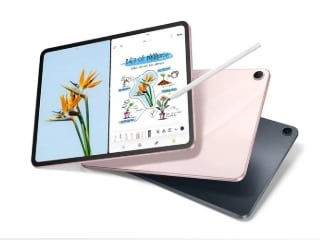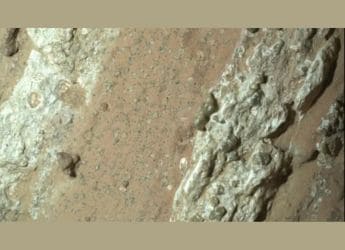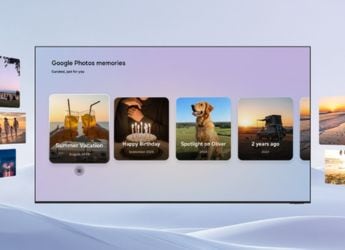- Home
- Science
- Science News
- NASA’s Hubble Space Telescope Shares Image of Celestial Cloudscape in Orion Nebula
NASA’s Hubble Space Telescope Shares Image of Celestial Cloudscape in Orion Nebula
This observation was part of a Hubble mosaic of the Orion Nebula, which was created from 520 images taken by the space telescope.

Photo Credit: ESA/Hubble & NASA, J. Bally
Hubble Space Telescope is a joint international project between NASA and ESA
In a detailed astronomical image, NASA's Hubble Space Telescope has captured a region of colourful dust and gas clouds encircling an HH 505 or a Herbig-Haro object in the Orion Nebula. Herbig-Haro objects, which are bright regions surrounding young stars, are created when stellar winds or jets of gas emitted by these stars collide violently with neighbouring gas and dust. In the instance of HH 505, these outflows come from the star IX Ori, which is located around 1,000 light-years from Earth on the edges of the Orion Nebula. The Orion Nebula's large-scale outflow of gas and dust interacts with the outflows themselves, which are seen as curved structures at the top and bottom of this image.
This interaction causes the outflows to be twisted into sinuous curves. In order to better understand the characteristics of outflows and protoplanetary discs, astronomers using Hubble's Advanced Camera for Surveys (ACS) made this discovery.
Bright, new stars spew powerful UV radiation into the Orion Nebula. Hubble can clearly see the shockwaves created by the outflows, but this radiation also draws attention to the slower-moving stellar material currents. This enables astronomers to see jets and outflows up close and understand their structures.
The Hubble Space Telescope is a joint international project between NASA and the European Space Agency (ESA). The ESA shared the detailed astronomical image on its website.
This observation was part of a Hubble mosaic of the Orion Nebula, which was created from 520 images taken by the space telescope, in five different colours and is the finest image of the region ever.
From the enormous, young stars forming the Orion Nebula to the pillars of dense gas that may serve as the homes of developing stars, it's a picture book of star creation. The four largest stars in the nebula are found in its core region. Because of the way the stars are organised, they are known as the Trapezium. These stars' ultraviolet radiation interrupts the formation of hundreds of lesser stars and cuts a hole in the nebula.
The nebula is also the region closest to the Earth where stars develop.
Get your daily dose of tech news, reviews, and insights, in under 80 characters on Gadgets 360 Turbo. Connect with fellow tech lovers on our Forum. Follow us on X, Facebook, WhatsApp, Threads and Google News for instant updates. Catch all the action on our YouTube channel.
Related Stories
- Samsung Galaxy Unpacked 2025
- ChatGPT
- Redmi Note 14 Pro+
- iPhone 16
- Apple Vision Pro
- Oneplus 12
- OnePlus Nord CE 3 Lite 5G
- iPhone 13
- Xiaomi 14 Pro
- Oppo Find N3
- Tecno Spark Go (2023)
- Realme V30
- Best Phones Under 25000
- Samsung Galaxy S24 Series
- Cryptocurrency
- iQoo 12
- Samsung Galaxy S24 Ultra
- Giottus
- Samsung Galaxy Z Flip 5
- Apple 'Scary Fast'
- Housefull 5
- GoPro Hero 12 Black Review
- Invincible Season 2
- JioGlass
- HD Ready TV
- Laptop Under 50000
- Smartwatch Under 10000
- Latest Mobile Phones
- Compare Phones
- Honor Win RT
- Honor Win
- Xiaomi 17 Ultra Leica Edition
- Xiaomi 17 Ultra
- Huawei Nova 15
- Huawei Nova 15 Pro
- Huawei Nova 15 Ultra
- OnePlus 15R
- Asus ProArt P16
- MacBook Pro 14-inch (M5, 2025)
- OPPO Pad Air 5
- Huawei MatePad 11.5 (2026)
- Xiaomi Watch 5
- Huawei Watch 10th Anniversary Edition
- Acerpure Nitro Z Series 100-inch QLED TV
- Samsung 43 Inch LED Ultra HD (4K) Smart TV (UA43UE81AFULXL)
- Asus ROG Ally
- Nintendo Switch Lite
- Haier 1.6 Ton 5 Star Inverter Split AC (HSU19G-MZAID5BN-INV)
- Haier 1.6 Ton 5 Star Inverter Split AC (HSU19G-MZAIM5BN-INV)

















